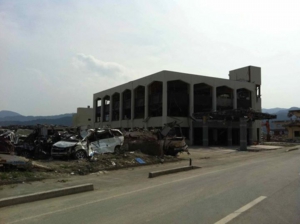Half a year has passed since 3.11, but eastern Japan is still far from recovery.
This summer, I visited Rikuzentakata city, one of the affected areas.
This city was utterly devastated by the disaster.
I've watched this city on-screen almost daily, but true devastation came as a shock of realization after seeing it with my own eyes.
Even the few buildings still standing in the big city, after a closer look, are useless structures.
In order to begin the reconstruction, these buildings must all be taken down,
but in order to do so, it will apparently cost 1,700,000,000 yen (approx. 22 million US$).
Yet neither the country nor the prefecture provides support.
Taxing citizens as before the disaster is impossible.
The city mayor, Mr. Toba lost his wife to the tsunami, and 68 city employees, 106, including temporary workers, have died. The city hall is destroyed.
To rebuild, the buildings must be taken down, the land cleared, urban planning restarted, develop the land and at least half of the city must be relocated on a mountain side.
How much will this cost and who will pay for it?
Most of those who have evacuated lost their homes and even their jobs.
Many had their entire premises swallowed by the tsunami.
However, after 6 months, unemployment benefits will be exhausted. Where can these people work?
Although what we can do as individuals may be small, I'm reminded that it is necessary to participate in long-term support.
The one pine tree, reduced from the 70,000 growing on the coast of Rikuzentakata,
much like the tree of life in Tarkovsky's final film, Sacrifice, stood weak and helpless.
18th July, 2o11 in Rikuzentakada/Iwate, Japan
Ryuichi Sakamoto

